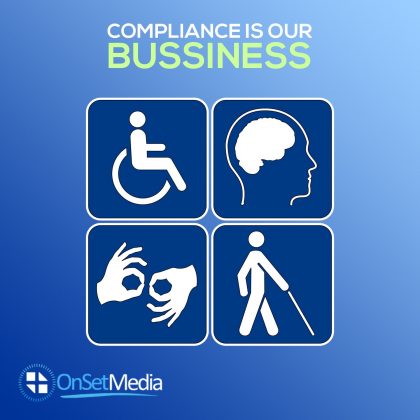WE INSTALL SOFTWARE THAT WILL MAKE YOUR WEBSITE COMPLIANT AND PROVIDE YOU WITH AN ACCESSIBILITY STATEMENT.
What is ADA Compliant? And do I need it if I’m a small business?
Today, by the power of the Americans with Disabilities Act (ADA), every business website has to be accessible to people with disabilities. The Law prohibits discrimination based on disability by places of “public accommodation”, meaning websites or brick-and-mortar facilities.
People with disabilities, specifically those who are blind or visually impaired, have been filing lawsuits against businesses over website accessibility issues, and many of them were winning. From 2017 to 2018, the number of federal website accessibility lawsuits nearly tripled, from 814 to 2258, according to the law firm Seyfarth Shaw, which states that this figure is on track to be slightly higher this year.
As a web agency, I feel that it is my responsibility to notify you directly about issues such as this. I strongly recommend that you solve this issue to avoid receiving a demand letter and getting into legal litigation that could be very costly in terms of time and money.
What is Web Accessibility?
Web accessibility is essentially a set of rules, behaviors, code standards, and design guidelines that were created by the W3C and are called the WCAG 2.1.
The WCAG 2.1 is a massive 1,000-page guidebook that encapsulates a range of disabilities that go from hindering internet use to making internet use impossible without adjustments. This spectrum actually comprises 20-25% of the general population depending on if we’re going with the CDC or WHO.
There are many disabilities covered, and the primary categories that require attention are:
- Blind people using screen-readers,
- The motor-impaired using only the keyboard to navigate,
- Epilepsy, color blindness,
- Cognitive and learning disabilities,
- Visual impairments, and more.
The WCAG 2.1 at the AA level has been adopted as the global standard for web accessibility acting as the benchmark in legislation such as the ADA title 3, Section 508, AODA, EN 301549, and many others.
About the Legislation
I wish I could tell you that the exponential increase in demand for web accessibility has been a result of everyone coming to understand that business owners and people with disabilities have so much to mutually gain from this endeavor.
Frankly, ADA compliance lawsuits are on nothing short of an intense rise. 200% year over year, with reports of 10’s of thousands of demand letters and lawsuits, targeting businesses of all sizes. At first, only the largest of enterprises and government institutions were legally pressured to become accessible, which makes sense. One of the most significant shifts in the legal climate was when the DOJ in the end of 2018 officially affirmed that all websites are considered public accommodations and therefore must comply with title 3 of the ADA. Many did not think for a second that it will ever happen to them, but that was not the case at all.
100% Compliant
Our accessibility tool is an AI-powered machine-learning software that was developed with the understanding that successfully automating the process creates a simple, immediate, affordable and compliant solution that serves as a win-win for the business owner and people with disabilities, who just want equal access to the internet.
Accessibility Statement?
It is important to note that one of the legal requirements of being ADA compliant is to have an accessibility statement that highlights your websites accessibility. This document on the right is our accessibility statement which also acts as a certificate of performance. It explains all the adjustments the solution has made to the website, browser and assistive technology compatibility and describes how to report feedback.
The statement will be personalized to the name of your domain and dated. It will be available to all users within the interface and sent to you via email, within 48 hours from the installation once the AI completes its process.

Features Explanation
We achieve compliance by leveraging two components.
- The first is our accessibility interface that is responsible for handling the UI, design and cognitive-related adjustments.
This interface is structured by disability profiles and enhancement features. That way, users with different disabilities can simply select the profile that best suits their needs. Among these profiles, you’ll find; an epilepsy safe profile, a visually impaired profile, cognitive disability profile, ADHD friendly profile. This interface is also fully customizable and can be fitted to your websites brand and design. - The second is our AI, machine learning-powered process, that handles keyboard navigation adjustments for the motor-impaired and blind people’s screen-readers.
A screen-reader is a software used by blind people to operate computers and websites and it’s installed on the operating system. It basically reads aloud the content focused on the screen, and it also helps with navigation and orientation aspects. Adjustments to those screen-readers are what the legislation requires.
accessiBe handles all on-site aspects using a “Contextual Understanding” AI technology that is responsible for remediating menus, drop-downs, pop-ups, forms, icons, buttons, and all other elements by applying the appropriate screen-reader text and website behaviors.
To automatically provide accurate alternative texts for images, also known as alt tags, our solution utilizes IRIS and OCR technologies to scan and learn the objects as well as the text that is embedded within the image.


